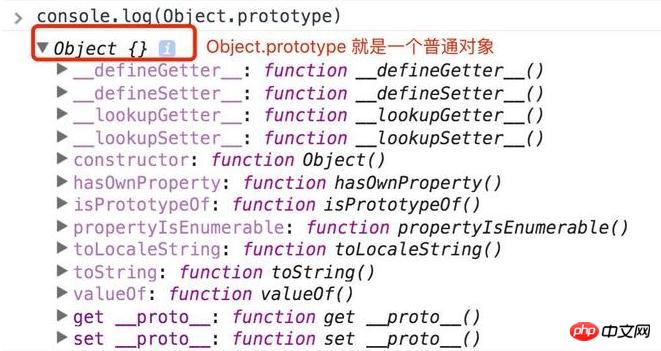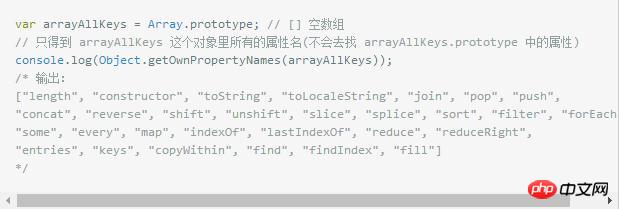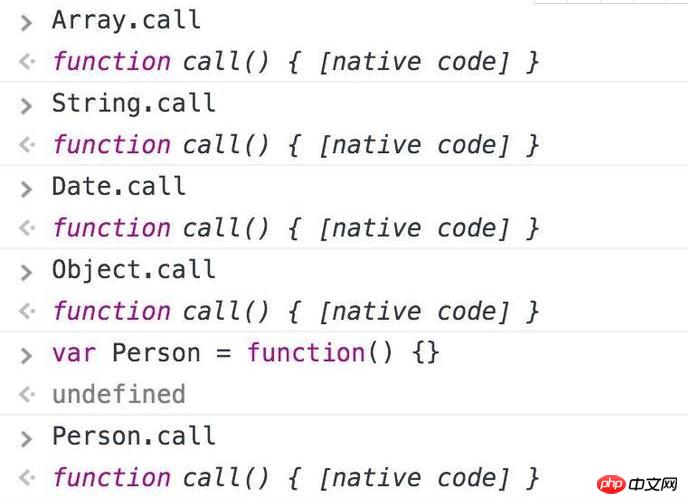Detailed explanation of JS prototype and prototype chain (3)
This time, following the previous article, let’s take a look at the JS prototype and prototype chain as well as the precautions. The following is a practical case, let’s take a look at it together.
7. Function objects (review the previous knowledge points)
The proto of all function objects All point to Function.prototype, which is an empty function (Empty function)
Number.__proto__ === Function.prototype // true Number.constructor == Function //true Boolean.__proto__ === Function.prototype // true Boolean.constructor == Function //true String.__proto__ === Function.prototype // true String.constructor == Function //true // 所有的构造器都来自于Function.prototype,甚至包括根构造器Object及Function自身 Object.__proto__ === Function.prototype // true Object.constructor == Function // true // 所有的构造器都来自于Function.prototype,甚至包括根构造器Object及Function自身 Function.__proto__ === Function.prototype // true Function.constructor == Function //true Array.__proto__ === Function.prototype // true Array.constructor == Function //true RegExp.__proto__ === Function.prototype // true RegExp.constructor == Function //true Error.__proto__ === Function.prototype // true Error.constructor == Function //true Date.__proto__ === Function.prototype // true Date.constructor == Function //true
There are a total of 12 built-in (build-in) constructors/objects in JavaScript (JSON is newly added in ES5), listed here 8 constructors accessible. The rest such as Global cannot be accessed directly, Arguments are only created by the JS engine when the function is called, Math and JSON exist in the form of objects and do not require new. Their proto is Object.prototype. As follows
Math.__proto__ === Object.prototype // true Math.construrctor == Object // true JSON.__proto__ === Object.prototype // true JSON.construrctor == Object //true
The function objects mentioned above certainly include custom ones. As follows
// 函数声明
function Person() {}
// 函数表达式
var Perosn = function() {}
console.log(Person.__proto__ === Function.prototype) // true
console.log(Man.__proto__ === Function.prototype) // trueWhat does this mean?
** All constructors come from Function.prototype, even the root constructor Object and Function itself. All constructors inherit the properties and methods of Function.prototype. Such as length, call, apply, bind**
(You should understand the first sentence, we will continue to talk about the second sentence in the next section, dig a hole first:))
Function.prototype is also The only prototype whose typeof XXX.prototype is function. The prototype of other constructors is an object (the reason has been explained in Section 3). As follows (reviewed again):
console.log(typeof Function.prototype) // function console.log(typeof Object.prototype) // object console.log(typeof Number.prototype) // object console.log(typeof Boolean.prototype) // object console.log(typeof String.prototype) // object console.log(typeof Array.prototype) // object console.log(typeof RegExp.prototype) // object console.log(typeof Error.prototype) // object console.log(typeof Date.prototype) // object console.log(typeof Object.prototype) // object
Oh, it was also mentioned above that it is an empty function. Take a look at console.log(Function.prototype) (note that we will talk about this again in the next section)
We know that the __proto__ of all constructors (including built-in and custom) are Function.prototype, so who is the __proto__ of Function.prototype?
I believe you have heard that functions in JavaScript are also first-class citizens, so how can you show this? As shown below
console.log(Function.prototype.__proto__ === Object.prototype) // true
This shows that all constructors are also ordinary JS objects, and attributes can be added/removed to the constructor. At the same time, it also inherits all methods on Object.prototype: toString, valueOf, hasOwnProperty, etc. (You should also understand the first sentence. We will continue to talk about the second sentence in the next section. There is no need to dig a hole, it is still the same hole;))
Who is the proto of Object.prototype in the end? ?
Object.prototype.__proto__ === null // true
has reached the top and is null. (Read it now and look back at Chapter 5. Do you understand?)
8. Prototype
Among all the attributes defined by the ECMAScript core, the most What is intriguing is the prototype attribute. For reference types in ECMAScript, the prototype is the real place where all their instance methods are stored. In other words, methods such as toString() and valueOf() are actually stored under the prototype name, but are accessed through instances of the respective objects.
——"JavaScript Advanced Programming" Third Edition P116
We know that JS has some built-in methods for us to use, such as:
Objects can use constructor/toString()/valueOf () and other methods;
Arrays can use map()/filter()/reducer() and other methods;
Numbers can use methods such as parseInt()/parseFloat();
Why? ? ?
When we create a function:
var Person = new Object()
Person is an instance of Object, so Person inherits Object’s prototype object Object.prototype All methods:

Object.prototype
Every instance of Object has the above properties and methods.
So I can use Person.constructor or Person.hasOwnProperty.
When we create an array:
var num = new Array()
num is an instance of Array, so num inherits Array’s prototype object Array.prototype All methods:

Array.prototype
Are you f***ing kidding me? Why is this an empty array? ? ?
We can use a new method provided by ES5: Object.getOwnPropertyNames
Get all property names (including non-enumerable properties) excluding properties in prototy, and return an array:

var arrayAllKeys = Array.prototype; // [] 空数组// 只得到 arrayAllKeys 这个对象里所有的属性名(不会去找 arrayAllKeys.prototype 中的属性)console.log(Object.getOwnPropertyNames(arrayAllKeys));
/* 输出:
["length", "constructor", "toString", "toLocaleString", "join", "pop", "push",
"concat", "reverse", "shift", "unshift", "slice", "splice", "sort", "filter", "forEach",
"some", "every", "map", "indexOf", "lastIndexOf", "reduce", "reduceRight",
"entries", "keys", "copyWithin", "find", "findIndex", "fill"]
*/
这样你就明白了随便声明一个数组,它为啥能用那么多方法了。
细心的你肯定发现了Object.getOwnPropertyNames(arrayAllKeys) 输出的数组里并没有 constructor/hasOwnPrototype等对象的方法(你肯定没发现)。
但是随便定义的数组也能用这些方法

var num = [1];console.log(num.hasOwnPrototype()) // false (输出布尔值而不是报错)
Why ???
因为Array.prototype 虽然没这些方法,但是它有原型对象(__proto__):
// 上面我们说了 Object.prototype 就是一个普通对象。 Array.prototype.__proto__ == Object.prototype
所以 Array.prototype 继承了对象的所有方法,当你用num.hasOwnPrototype()时,JS 会先查一下它的构造函数 (Array) 的原型对象 Array.prototype 有没有有hasOwnPrototype()方法,没查到的话继续查一下 Array.prototype 的原型对象 Array.prototype.__proto__有没有这个方法。
当我们创建一个函数时:
var f = new Function("x","return x*x;");
//当然你也可以这么创建 f = function(x){ return x*x }
console.log(f.arguments) // arguments 方法从哪里来的?
console.log(f.call(window)) // call 方法从哪里来的?
console.log(Function.prototype) // function() {} (一个空的函数)
console.log(Object.getOwnPropertyNames(Function.prototype));
/* 输出
["length", "name", "arguments", "caller", "constructor", "bind", "toString", "call", "apply"]
*/我们再复习第八小节这句话:
所有函数对象proto都指向 Function.prototype,它是一个空函数(Empty function)
嗯,我们验证了它就是空函数。不过不要忽略前半句。我们枚举出了它的所有的方法,所以所有的函数对象都能用,比如:

九. 复习一下
第八小节我们总结了:
所有函数对象的 __proto__ 都指向 Function.prototype,它是一个空函数(Empty function)
但是你可别忘了在第三小节我们总结的:
所有对象的 __proto__ 都指向其构造器的 prototype
我们下面再复习下这句话。
先看看 JS 内置构造器:
var obj = {name: 'jack'}
var arr = [1,2,3]
var reg = /hello/g
var date = new Date
var err = new Error('exception')
console.log(obj.__proto__ === Object.prototype) // true
console.log(arr.__proto__ === Array.prototype) // true
console.log(reg.__proto__ === RegExp.prototype) // true
console.log(date.__proto__ === Date.prototype) // true
console.log(err.__proto__ === Error.prototype) // true再看看自定义的构造器,这里定义了一个 Person:
function Person(name) {
this.name = name;
}
var p = new Person('jack')
console.log(p.__proto__ === Person.prototype) // truep 是 Person 的实例对象,p 的内部原型总是指向其构造器 Person 的原型对象 prototype。
每个对象都有一个 constructor 属性,可以获取它的构造器,因此以下打印结果也是恒等的:
function Person(name) {
this.name = name
}
var p = new Person('jack')
console.log(p.__proto__ === p.constructor.prototype) // true上面的Person没有给其原型添加属性或方法,这里给其原型添加一个getName方法:
function Person(name) {
this.name = name
}
// 修改原型
Person.prototype.getName = function() {}
var p = new Person('jack')
console.log(p.__proto__ === Person.prototype) // true
console.log(p.__proto__ === p.constructor.prototype) // true可以看到p.__proto__与Person.prototype,p.constructor.prototype都是恒等的,即都指向同一个对象。
如果换一种方式设置原型,结果就有些不同了:
function Person(name) {
this.name = name
}
// 重写原型Person.prototype = {
getName: function() {}
}
var p = new Person('jack')
console.log(p.__proto__ === Person.prototype) // true
console.log(p.__proto__ === p.constructor.prototype) // false这里直接重写了 Person.prototype(注意:上一个示例是修改原型)。输出结果可以看出p.__proto__仍然指向的是Person.prototype,而不是p.constructor.prototype。
这也很好理解,给Person.prototype赋值的是一个对象直接量{getName: function(){}},使用对象直接量方式定义的对象其构造器(constructor)指向的是根构造器Object,Object.prototype是一个空对象{},{}自然与{getName: function(){}}不等。如下:
var p = {}
console.log(Object.prototype) // 为一个空的对象{}
console.log(p.constructor === Object) // 对象直接量方式定义的对象其constructor为Objectconsole.log(p.constructor.prototype === Object.prototype) // 为true,
不解释(๑ˇ3ˇ๑)十. 原型链(再复习一下:)
下面这个例子你应该能明白了!
function Person(){
}var person1 = new Person();
console.log(person1.__proto__ === Person.prototype); // true
console.log(Person.prototype.__proto__ === Object.prototype) //true
console.log(Object.prototype.__proto__) //null
Person.__proto__ == Function.prototype; //true
console.log(Function.prototype)// function(){} (空函数)
var num = new Array()console.log(num.__proto__ == Array.prototype) // true
console.log( Array.prototype.__proto__ == Object.prototype) // true
console.log(Array.prototype) // [] (空数组)
console.log(Object.prototype.__proto__) //null
console.log(Array.__proto__ == Function.prototype)// true疑点解惑:
Object.__proto__ === Function.prototype // true
Object 是函数对象,是通过new Function()创建的,所以Object.__proto__指向Function.prototype。(参照第八小节:「所有函数对象的__proto__都指向Function.prototype」)
Function.__proto__ === Function.prototype // true
Function 也是对象函数,也是通过new Function()创建,所以Function.__proto__指向Function.prototype。
自己是由自己创建的,好像不符合逻辑,但仔细想想,现实世界也有些类似,你是怎么来的,你妈生的,你妈怎么来的,你姥姥生的,……类人猿进化来的,那类人猿从哪来,一直追溯下去……,就是无,(NULL生万物)
正如《道德经》里所说“无,名天地之始”。
Function.prototype.__proto__ === Object.prototype //true
其实这一点我也有点困惑,不过也可以试着解释一下。
Function.prototype是个函数对象,理论上他的__proto__应该指向 Function.prototype,就是他自己,自己指向自己,没有意义。
JS一直强调万物皆对象,函数对象也是对象,给他认个祖宗,指向Object.prototype。Object.prototype.__proto__ === null,保证原型链能够正常结束。
十一 总结
原型和原型链是JS实现继承的一种模型。
原型链的形成是真正是靠__proto__ 而非prototype
要深入理解这句话,我们再举个例子,看看前面你真的理解了吗?
var animal = function(){}; var dog = function(){};
animal.price = 2000;
dog.prototype = animal; var tidy = new dog(); console.log(dog.price) //undefined
console.log(tidy.price) // 2000这里解释一下:
var dog = function(){};
dog.prototype.price = 2000; var tidy = new dog(); console.log(tidy.price); // 2000
console.log(dog.price); //undefined
var dog = function(){}; var tidy = new dog();
tidy.price = 2000; console.log(dog.price); //undefined这个明白吧?想一想我们上面说过这句话:
实例(tidy)和 原型对象(dog.prototype)存在一个连接。不过,要明确的真正重要的一点就是,这个连接存在于实例(tidy)与构造函数的原型对象(dog.prototype)之间,而不是存在于实例(tidy)与构造函数(dog)之间。
聪明的你肯定想通了吧 :)
The above is the detailed content of Detailed explanation of JS prototype and prototype chain (3). For more information, please follow other related articles on the PHP Chinese website!

Hot AI Tools

Undresser.AI Undress
AI-powered app for creating realistic nude photos

AI Clothes Remover
Online AI tool for removing clothes from photos.

Undress AI Tool
Undress images for free

Clothoff.io
AI clothes remover

AI Hentai Generator
Generate AI Hentai for free.

Hot Article

Hot Tools

Notepad++7.3.1
Easy-to-use and free code editor

SublimeText3 Chinese version
Chinese version, very easy to use

Zend Studio 13.0.1
Powerful PHP integrated development environment

Dreamweaver CS6
Visual web development tools

SublimeText3 Mac version
God-level code editing software (SublimeText3)

Hot Topics
 1377
1377
 52
52
 Detailed explanation of obtaining administrator rights in Win11
Mar 08, 2024 pm 03:06 PM
Detailed explanation of obtaining administrator rights in Win11
Mar 08, 2024 pm 03:06 PM
Windows operating system is one of the most popular operating systems in the world, and its new version Win11 has attracted much attention. In the Win11 system, obtaining administrator rights is an important operation. Administrator rights allow users to perform more operations and settings on the system. This article will introduce in detail how to obtain administrator permissions in Win11 system and how to effectively manage permissions. In the Win11 system, administrator rights are divided into two types: local administrator and domain administrator. A local administrator has full administrative rights to the local computer
 Detailed explanation of division operation in Oracle SQL
Mar 10, 2024 am 09:51 AM
Detailed explanation of division operation in Oracle SQL
Mar 10, 2024 am 09:51 AM
Detailed explanation of division operation in OracleSQL In OracleSQL, division operation is a common and important mathematical operation, used to calculate the result of dividing two numbers. Division is often used in database queries, so understanding the division operation and its usage in OracleSQL is one of the essential skills for database developers. This article will discuss the relevant knowledge of division operations in OracleSQL in detail and provide specific code examples for readers' reference. 1. Division operation in OracleSQL
 Detailed explanation of the role and usage of PHP modulo operator
Mar 19, 2024 pm 04:33 PM
Detailed explanation of the role and usage of PHP modulo operator
Mar 19, 2024 pm 04:33 PM
The modulo operator (%) in PHP is used to obtain the remainder of the division of two numbers. In this article, we will discuss the role and usage of the modulo operator in detail, and provide specific code examples to help readers better understand. 1. The role of the modulo operator In mathematics, when we divide an integer by another integer, we get a quotient and a remainder. For example, when we divide 10 by 3, the quotient is 3 and the remainder is 1. The modulo operator is used to obtain this remainder. 2. Usage of the modulo operator In PHP, use the % symbol to represent the modulus
 Detailed explanation of the linux system call system() function
Feb 22, 2024 pm 08:21 PM
Detailed explanation of the linux system call system() function
Feb 22, 2024 pm 08:21 PM
Detailed explanation of Linux system call system() function System call is a very important part of the Linux operating system. It provides a way to interact with the system kernel. Among them, the system() function is one of the commonly used system call functions. This article will introduce the use of the system() function in detail and provide corresponding code examples. Basic Concepts of System Calls System calls are a way for user programs to interact with the operating system kernel. User programs request the operating system by calling system call functions
 Detailed explanation of Linux curl command
Feb 21, 2024 pm 10:33 PM
Detailed explanation of Linux curl command
Feb 21, 2024 pm 10:33 PM
Detailed explanation of Linux's curl command Summary: curl is a powerful command line tool used for data communication with the server. This article will introduce the basic usage of the curl command and provide actual code examples to help readers better understand and apply the command. 1. What is curl? curl is a command line tool used to send and receive various network requests. It supports multiple protocols, such as HTTP, FTP, TELNET, etc., and provides rich functions, such as file upload, file download, data transmission, proxy
 Simple JavaScript Tutorial: How to Get HTTP Status Code
Jan 05, 2024 pm 06:08 PM
Simple JavaScript Tutorial: How to Get HTTP Status Code
Jan 05, 2024 pm 06:08 PM
JavaScript tutorial: How to get HTTP status code, specific code examples are required. Preface: In web development, data interaction with the server is often involved. When communicating with the server, we often need to obtain the returned HTTP status code to determine whether the operation is successful, and perform corresponding processing based on different status codes. This article will teach you how to use JavaScript to obtain HTTP status codes and provide some practical code examples. Using XMLHttpRequest
 Detailed analysis of C language learning route
Feb 18, 2024 am 10:38 AM
Detailed analysis of C language learning route
Feb 18, 2024 am 10:38 AM
As a programming language widely used in the field of software development, C language is the first choice for many beginner programmers. Learning C language can not only help us establish the basic knowledge of programming, but also improve our problem-solving and thinking abilities. This article will introduce in detail a C language learning roadmap to help beginners better plan their learning process. 1. Learn basic grammar Before starting to learn C language, we first need to understand the basic grammar rules of C language. This includes variables and data types, operators, control statements (such as if statements,
 Learn more about Promise.resolve()
Feb 18, 2024 pm 07:13 PM
Learn more about Promise.resolve()
Feb 18, 2024 pm 07:13 PM
Detailed explanation of Promise.resolve() requires specific code examples. Promise is a mechanism in JavaScript for handling asynchronous operations. In actual development, it is often necessary to handle some asynchronous tasks that need to be executed in sequence, and the Promise.resolve() method is used to return a Promise object that has been fulfilled. Promise.resolve() is a static method of the Promise class, which accepts a




